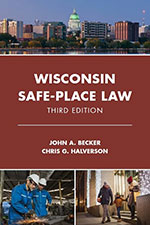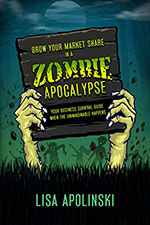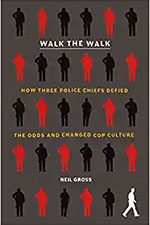 VERDICT: Touchdown!
VERDICT: Touchdown!
Wisconsin Safe-Place Law, Third Edition
By John A. Becker & Chris G. Halverson (Racine, WI: Nevin Publishing, 2022). 458 pgs. $129. Order, www.nevinpublishing.com.
Reviewed by Theresa B. Laughlin
Thank you to authors John A. Becker and Chris G. Halverson for the long overdue Wisconsin Safe-Place Law, Third Edition. Lawyers who handle premises-liability cases in Wisconsin have long relied on Howard H. Boyle Jr.’s reference book on safe-place law, which these authors have now brought up to date.
Want to Review a Book?
Please request a book and writing guidelines from the Wisconsin Lawyer managing editor at wislawmag@wisbar.org. Reviewers may keep the book reviewed. Reviews of about 500 words are due within 45 days of receiving the book. Reviews are published, space permitting, in the order received and may be edited for length and clarity.
Wisconsin enacted Wis. Stat. section 101.11, the so-called safe-place statute, in 1911. The law created an enhanced duty of care for employers and owners of public buildings. While ordinary negligence requires a premises to be reasonably safe, the safe-place statute requires it be as safe as the nature of the premises would reasonably permit. For tort lawyers, the safe-place statute is often the basis for cases in which people have been injured after falling.
In Wisconsin Safe-Place Law, Third Edition, theauthors provide a comprehensive survey of more than 100 years of safe-place law. The book follows the familiar format of Boyle’s book, with six chapters covering the same topics – Introduction, Places Covered, Persons Liable, Conditions Covered, Person Protected, and Safe Place Actions. The table of contents is highly detailed so that readers can quickly turn to the desired section. It also includes useful case and subject indexes.
The authors incorporate case law that has developed over the last 40 years with that referenced and analyzed in Boyle’s version. This was a hefty task because of the many developments in the area. In addition to updating and adding current case law, they also provide new analysis sections that discuss issues that have arisen due to perceived conflicts in the case law. Some of the areas with additional analysis from the authors include the acts-of-operation rule, duties owed to frequenters, and recreational and governmental immunity. There are also several helpful practice pointers throughout the book.
The analysis of governmental immunity as it applies to a safe-place claim is an example of how deeply the authors delved into the topic. Early law was that governmental entities had immunity from tort claims, except for ministerial acts and safe-place violations. Some subsequent cases have either misinterpreted or completely ignored those earlier holdings. The book comprehensively reviews all the case law on that subject and provides a detailed analysis for lawyers.
If you have a question about Wisconsin safe-place law, odds are the answer will be included in this book. It is a helpful tool for lawyers handling their first fall case to those with extensive experience with these matters. It is a must-have reference for anyone who handles premise-liability cases in Wisconsin.
Theresa Laughlin, U.W. 1995, is a shareholder at Habush, Habush & Rottier S.C. in Wausau.
 VERDICT: It’s a Keeper
VERDICT: It’s a Keeper
Psych 101 for Attorneys: A Manual for Litigating Psychiatric Injury Claims
By Michael A. D’Anton (2022). 170 pgs. $10.99. Order, www.amazon.com.
Reviewed by Frederic W. Knaak
Author Michael D’Anton expresses his hope that Psych 101 for Attorneys will convince readers to “be prepared, retain a qualified expert, obtain, review and produce all of the data, and when necessary, move to strike a purported expert and her or his unscientific report.”
To that end, D’Anton calls on his nearly 40 years of experience as both a psychologist and a litigator to go into some detail into the often (for outsiders) confusing nuances and differences among health-care-professional qualifications and the exact sorts of things lawyers should be considering not only in hiring such an individual to assist in a psychiatric injury case but also in critically assessing an opposing expert.
Although the focus is psychiatric injuries, the book also provides a useful general discussion of the tactical and strategic use of mental-health-care professionals in litigation and should not be viewed as being only related to psychiatric injuries. D’Anton’s review of discovery and, in particular, deposition tactics using these professionals is sprinkled with personal anecdotes based on his experiences as a litigator as well as an expert psychologist; he also has considerable experience in testifying in cases himself. He makes a very strong case for exhaustively reviewing all possible medical records and avoiding shortcuts and suggests the sorts of records that should be sought.
Relatively short at just over 160 pages, the book is a must read for lawyers, especially ones not familiar with the use of mental-health-care professionals who are about to engage in a case in which they will or should be an active participant as a consultant or expert witness. D’Anton’s experience and his frequent anecdotal examples serve as a very good guide as to what to look for and avoid. That length, it should be said, belies a somewhat rambling, casual, and repetitive style some readers might find distracting. Even so, it has the feel of an old, experienced practitioner sharing hard won insights that any litigator could appreciate.
Frederic W. Knaak, Minnesota 1978, practices with North Star Law Group in Saint Paul, Minn.
 VERDICT: It’s a Keeper
VERDICT: It’s a Keeper
Grow Your Market Share in a Zombie Apocalypse: Your Business Survival Guide When the Unimaginable Happens
By Lisa Apolinski (Oceanside, CA: Indie Books International Inc., 2022). 116 pgs. $20. Order, www.amazon.com.
Reviewed by Jon E. Anderson
Few people predicted the pandemic. Yet the pandemic happened. What’s next? This book by Lisa Apolinski is promoted on its cover as a “business survival guide when the unimaginable happens.” While that is a tall order, the book identifies essential habits business leaders should embrace to advance their business no matter which cards they have been dealt. Apolinski suggests that by embracing and practicing these habits and making them routine, readers will be able to respond to the turbulent and uncertain situations that inevitably interfere with the best-laid plans.
Through a variety of anecdotes, and building on research, the book will help lawyers critically think about and assess their businesses and then use that information to prepare for an uncertain future. Keeping an eye on the ball and a keen focus on the reward for doing so is the foundation for any business plan.
This book offers plenty of practical ideas that business leaders (and lawyers) can practice on a regular basis to increase their market share when things are good and when they are not so good.
While many of the ideas here are not new, they are presented in a thoughtful way. Business leaders, including lawyers, can use the ideas as tools to build a framework for growing market share. Apolinski urges business leaders to be bold and direct in their business development plans. Using social media, developing prospect lists, and starting an action plan based on small, daily business development activities are things everyone can do.
Understanding the client base, being deliberate in building relationships, and learning how to leverage them are practical, and proven, ways to gain market share. Apolinski also urges business leaders to be “municifent” or generous in cultivating relationships. Making these ideas, or habits, a routine part of your practice will serve you well in your business journey as you navigate through the unpredictable and unimaginable.
This book is an easy read offering many ideas for growth that business leaders and lawyers can use as they develop or fine tune their business development plans.
Jon E. Anderson, Marquette 1981, practices with Husch Blackwell LLP, Madison.
 VERDICT: Touchdown!
VERDICT: Touchdown!
Walk the Walk: How Three Police Chiefs Defied the Odds and Changed Cop Culture
By Neil Gross (New York, NY: Metropolitan Books, Henry Holt & Co., 2023). 250 pgs. $27.99. Order, www.amazon.com.
Reviewed by Jennifer Williams
Policing, public safety, and the criminal justice system are relevant and highly charged topics. The charged nature of debates on policing often do little service to the realities law enforcement officers face as a profession and their power to both positively and negatively affect communities. How then, given this extraordinary power to influence people’s daily lives, can the institutional standards of a law enforcement agency be understood and how can the democratic values enshrined in the ideals of the U.S. Constitution be promoted and empowered? For Neil Gross, author of Walk the Walk, “cop culture” is the key.
To answer these questions, Gross studied three different, and distinct, communities actively engaged in this debate of “what should we do about the police.” If an institution is faced with calls for reform, is that reform best imposed from the outside or is it an inside job? Gross looks at three police chiefs (from Stockton, California; Longmont, Colorado; and LaGrange, Georgia) to examine and follow how each department implemented and responded to change.
Gross’ book uses interviews, in-depth observations of long-term partnerships, anecdotes, and historical and academic sources to guide readers through this inquiry. From examining procedural justice – and its focus on fairness – and its application in Stockton, Calif., to restorative justice and harm reduction efforts in Longmont, Calif., Gross develops a familiarity in concepts that may seem obvious. Procedural justice is based in fairness, but what and how does that function in day-to-day interactions between individual officers and the people they encounter in their communities? Gross answers this question by anecdote, observations of those interactions, and research on crime statistics.
Gross leaves the best for last: Lou Dekmar, chief of police in LaGrange, Georgia. Dekmar’s department worked closely, although initially reluctantly, with community partners, the NAACP, and Hope in the Cities (a nonprofit organization) to start building bridges and dialogue between police officers and community members. This partnership led to an extraordinary moment: Dekmar discovered a long-forgotten lynching episode in his community. In 1940, Austin Calloway, who had been arrested by local police, was taken from the LaGrange jail when six masked men demanded the jailer release Calloway to them. The jailer complied, and Calloway was driven out of town by the masked men and fatally shot. 80 years later, Dekmar organized, in partnership with local government and community leaders, a public apology for his department’s role in failing to protect Calloway from his murderers.
It is this powerful example that provides the theme of Gross’ book: “[t]he past misdeed can become a lesson in what the organization will no longer tolerate.” (Gross, p. 205.) It is this example, which leads to his ultimate message: change is possible, and hope is unfailing.
Jennifer Williams, Marquette 2007, is deputy city attorney for the Litigation Section of the Milwaukee City Attorney’s Office and an adjunct professor at Marquette University’s Criminology Department.
» Cite this article: 96 Wis. Law. 28-30 (November 2023).
